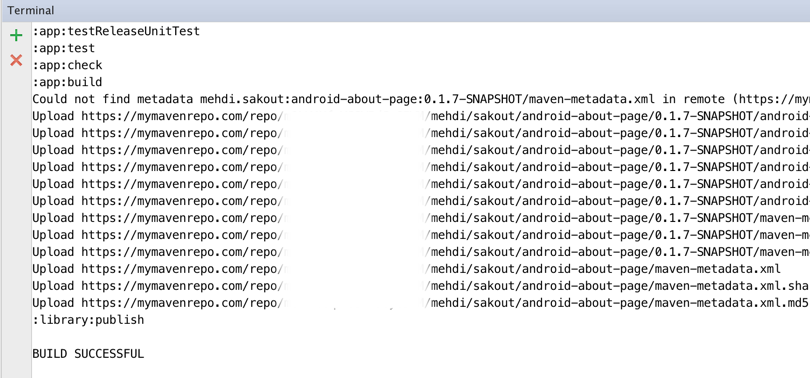How to Set Up a Private Maven Repository For Free

I recently decided to extract some redundant modules from my released Android Apps and make them standalone to be used in future projects. I ended up having easy to use dependencies like this compile {libraryName}, seems cool ? nah ?
This guide applies only for private projects that you’d like to keep in secret, or share solely with agency teammates… if you’d like to go public, check Bintray, Maven Central or Jitpack.
At the end of this guide, you’ll be able to have something like :
compile "my.company.library:version"
Ready ? Let’s get Go
My current configuration is :
- Gradle 2.11
- Android Plugin for Gradle 2.1.0-beta1
- Android Studio 2.1
- MacOS X 10.10.5

Instead of building a private maven server repository which costs time and money, I’ve opted for a self hosted version called named MyMavenRepo.com, At the time of writing this article, the service remains free and offers 250mb of data plus supports maven and gradle build types.
1 - Setup an Account
Okay, start by creating a new account, you’ll receive the password in your inbox.
2 - Setup Dev Environment
Once on your dashboard, you’ll identify two different URLs:
Read URL : https://mymavenrepo.com/repo/myUniqueID/Write URL : https://mymavenrepo.com/repo/myUniqueID/
These urls are used to read/write data to our repository, they come with a unique ID to identify your repository, make sure to keep them private, if you don’t set any permissions, anyone could access your content.
On the HTTP Basic Auth Section, click on enable HTTP Basic Auth to be able to restrict access by username and password.
Once done, you’ll have to setup the authentification details, Click on Add User and define your default user for both READ and WRITE urls, I won’t cover this part, it’s really up to you.
Now, it’s time to export all these variables to our gradle.properties
$ vim .gradle/gradle.properties
Change with your password and repo url:
myMavenRepoReadPassword=myPassword
myMavenRepoWritePassword= myPassword
myMavenRepoReadUrl=https://mymavenrepo.com/repo/uniqueID/
myMavenRepoWriteUrl=https://mymavenrepo.com/repo/uniqueID/
3 - Update your dependency project and Push Content
Upgrade your library build.gradle file like below
apply plugin: 'maven-publish'
group = 'my.company'
archivesBaseName = 'android-library'
version = '0.1.4-SNAPSHOT'
publishing {
repositories {
maven {
url myMavenRepoWriteUrl
credentials {
username 'myMavenRepo'
password myMavenRepoReadPassword
}
}
}
publications {
aar(MavenPublication) {
groupId group
artifactId archivesBaseName
version project.version
// Optional
pom.withXml {
asNode().appendNode('name','Dependency Name')
asNode().appendNode('description','Dependency Description')
asNode().appendNode('url','http://medyo.github.com')
}
artifact("$buildDir/outputs/aar/${archivesBaseName}-release.aar") }
}
}
Ready ? Go
./gradlew clean build publish
If things go like expected, you should see in log the remote path of your dependency

4 - Distribution
Hooray ! You’re done, your library is ready to be shared with your teammates, Just Ask them to upgrade their gradle files
Add this to your top build.gradle file:
maven {
url "https://mymavenrepo.com/repo/UniqueID/"
credentials {
username = 'myMavenRepo'
password = '********'
}
}
And integrate your dependency like you you’ve always done :
compile 'my.company:android-library:0.1.4-SNAPSHOT'
For any suggestions or questions, please post your comment below.
Thanks